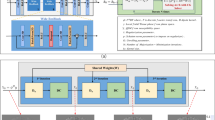Abstract
Although anisotropic diffusion filters have been used extensively and with great success in medical image denoising, one limitation of this iterative approach, when used on fully automatic medical image processing schemes, is that the quality of the resulting denoised image is highly dependent on the number of iterations of the algorithm. Using many iterations may excessively blur the edges of the anatomical structures, while a few may not be enough to remove the undesirable noise. In this work, a mathematical model is proposed to automatically determine the number of iterations of the robust anisotropic diffusion filter applied to the problem of denoising three common human brain magnetic resonance (MR) images (T1-weighted, T2-weighted and proton density). The model is determined off-line by means of the maximization of the mean structural similarity index, which is used in this work as metric for quantitative assessment of the resulting processed images obtained after each iteration of the algorithm. After determining the model parameters, the optimal number of iterations of the algorithm is easily determined without requiring any extra computation time. The proposed method was tested on 3D synthetic and clinical human brain MR images and the results of qualitative and quantitative evaluation have shown its effectiveness.










Similar content being viewed by others
References
Fu S, Ruan Q, Wang W, Li Y (2006) Adaptive anisotropic diffusion for ultrasonic image denoising and edge enhancement. Int J Info Commun Eng 2(8):562–570
Perona P, Malik J (1990) Scale-space and edge detection using anisotropic diffusion. IEEE Trans Pattern Anal Mach Intell 12(7):629–639
Gerig G, Kubler O, Kikinis R, Jolesz F (1992) Nonlinear anisotropic filtering of MRI data. IEEE Trans Med Imaging 11(2):221–232
Black M, Sapiro G, Marimont D, Heeger D (1998) Robust anisotropic diffusion. IEEE Trans Image Process 7(3):421–432
Weickert J (1999) Coherence-enhancing diffusion of colour images. Image Vis Comput 17(3):201–212
Wang Z, Bovik A, Sheikh H, Simoncelli E (2004) Image quality assessment: from error visibility to structural similarity. IEEE Trans Image Process 13(4):600–612
Wang Z, Bovik A (2009) Mean squared error: love it or leave it? IEEE Signal Process Magn 26(1):98–117
Solo V (2005) A fast automatic stopping criterion for anisotropic diffusion. In: Proceedings of IEEE international conference on acoustics speech and signal, Orlando, 2002, pp 1661–1664
Mrazek P, Navara M (2003) Selection of optimal stopping time for nonlinear diffusion filtering. Int J Comput Vis 2(3):189–203
Papandreou G, Maragos P (2005) A cross-validatory statistical approach to scale selection for image denoising by nonlinear diffusion. In: Proceedings of the conference on computer vision and pattern recognition (CVPR), San Diego, 625–630
Barcelos C, Boaventura M, Silva-Jr E (2005) Edge detection and noise removal by use of a partial differential equation with automatic selection of parameters. Comput App Math 24(1):131–150
Rinne H (2009) The Weibull distribution: a handbook, Chapman and Hall/CRC, Boca Raton
Aubert-Broche B, Griffin M, Pike G, Evans A, Collins D (2006) Twenty new digital brain phantoms for creation of validation image data bases. IEEE Trans Med Imaging 25(11):1410–1416
Macovski A. (1996) Noise in MRI. Magn Reson Med 36(3):494–497
Wright G (1997) Magnetic resonance imaging. Signal Process Magn 14(1):56–66
Henkelman R (1985) Measurement of sinal intensities in the presence of noise in MR images. Med Phys 12(2):232–233
Gonzales RC, Wintz P (1987) Digital image processing (2nd edn), Addison-Wesley Longman Publishing Co., Inc., Boston
Sijbers J, den Dekker A, Scheunders P, Dyck D (1998) Maximum-likelihood estimation of rician distribution parameters. IEEE Trans Med Imaging 17(3):357–361
Coupé P, Manjón J, Gedamu E, Arnold D, Robles M, Collins D (2010) Robust rician noise estimation for MR images. Med Image Anal 14(4):483–493
Otsu N (1979) A threshold selection method from gray-level histograms. IEEE Trans. Syst Man Cybern 9(1):62–66
Hoaglin D, Mosteller F, Tukey J (Eds) (1983) Understanding robust and exploratory data analysis, Wiley series in probability and mathematical statistics. Wiley-Interscience, New York
Witkin A (1984) Scale-space filtering: a new approach to multi-scale description. In: Acoustics, speech, and signal processing. IEEE international conference on ICASSP ‘84, 9:150–153
Black M, Sapiro G, Marimont D, Heeger D (1998) Robust anisotropic diffusion. IEEE Trans Image Process 7(3):421–432
Manjón J, Carbonell-Caballero J, Lull J, García-Martí G, Martí-Bonmatí L, Robles M (2008) Mri denoising using non local means. Med Image Anal 12(4):514–523.
Manjón JV, Coupé P, Martí-Bonmatí L, Collins DL, Robles M (2010) Adaptive non-local means denoising of mr images with spatially varying noise levels. J Magn Reson Imaging 31(1):192–203
Anand C, Sahambi J (2010) Wavelet domain non-linear filtering for mri denoising. Magn Reson Imaging Clin N Am 28(6):842–861
Wang Y, Che X, Ma S (2012) Nonlinear filtering based on 3d wavelet transform for mri denoising. EURASIP J Adv Signal Process 40:1–14
Acknowledgments
The author is thankful to the Associate Editor and the reviewers, and to his colleague Mario Leziér, PhD, Professor, for all very valuable comments and references that helped to improve the paper. The author also expresses his gratitude to the all team from brain-development.org @ imperial college (http://www.brain-development.org/) for providing clinical MR images for this study. This work received financial support from the Fundação de Amparo à Pesquisa do Estado de São Paulo (FAPESP-processes numbers: 2008/09050-2 and 2012/03100-3), and from the Conselho Nacional de Desenvolvimento Científico e Tecnológico (CNPq-process number: 300803/2009-5).
Author information
Authors and Affiliations
Corresponding author
Additional information
Grants or other notes about the article that should go on the front page should be placed here. General acknowledgments should be placed at the end of the article.
Rights and permissions
About this article
Cite this article
Ferrari, R.J. Off-line determination of the optimal number of iterations of the robust anisotropic diffusion filter applied to denoising of brain MR images. Med Biol Eng Comput 51, 71–88 (2013). https://doi.org/10.1007/s11517-012-0971-z
Received:
Accepted:
Published:
Issue Date:
DOI: https://doi.org/10.1007/s11517-012-0971-z




